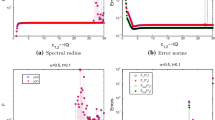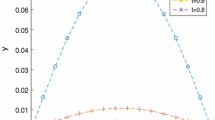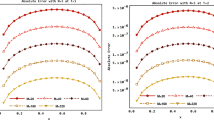Abstract
In this article, a meshless spectral radial point interpolation method is proposed for the numerical solutions of a class of time-fractional advection–diffusion–reaction equations. The current approach utilizes meshless shape functions, having Kronecker delta function property, for approximation of spatial operators. Forward difference along with quadrature formula is used for tempered fractional derivative approximation in the framework of implicit time marching scheme. Assessment of the proposed method is made by applying to various concrete test problems having constant and variable coefficients. Approximation and function reproduction quality are measured via \({E}_{\infty }\), \({E}_{2}\) and \({E}_{\text {rms}}\) error norms. Comparison of simulated results is also made with available exact solutions as well as earlier reported works. Stability analysis of the proposed method is thoroughly discussed and computationally affirmed.











Similar content being viewed by others
References
LHilfer R (2000) Applications of fractional calculus in physics. World Scientific, River Edge
Podlubny I (1999) Fractional differential equations. Academic, San Diego, p 198
Fallahgoul HA, Focardi SM, Fabozzi FJ (2017) Fractional calculus and fractional processes with applications to financial economics: Theory and Applications. Elsevier, Oxford
Mainardi F (1997) Fractional calculus: Some basic problems in continuum and statistical mechanics. In: carpinteri A, Mainardi F (eds) Fractals and fractional calculus in continuum mechanics. Springer, New York, pp 291–348
Fujita Y (1990) Cauchy problems of fractional order and stable processes. Jpn J Appl Math 7(3):459–476
Hilfer R (1995) Foundations of fractional dynamics. Fractals 3(3):549–556
Hilfer R (2000) Fractional diffusion based on Riemann-Liouville fractional derivative. J Phys Chem 104:3914–3917
Caputo M (1967) Linear models of dissipation whose \(Q\) is almost frequency independent, Part II. J R Astral Soc 13:529–539
Metzler JKR (2000) The random walks guide to anomalous diffusion: a fractional dynamics approach. Phys Rep 339:1–77
Schumer R, Benson DA, Meerschaert MM et al (2003) Fractal mobile/immobile solute transport. Water Resour Res 39(10):1296
Schumer R, Meerschaert MM, Baeumer B (2009) Fractional advection-dispersion equations for modeling transport at the Earth surface. J Geophys Res 114:F00A07. https://doi.org/10.1029/2008JF001246
Akrami MH, Erjaee GH (2015) Examples of analytical solutions by means of Mittag-Leffler function of fractional Black-Scholes option pricing equations. Fract Calc Appl Anal 18(1):38–47
Liu F, Zhuang P, Anh V et al (2007) Stability and convergence of the difference methods for the space-time fractional advection-diffusion equation. Appl Math Comput 191:12–20
Tadjeran C, Meerschaert MM, Scheffler H-P (2006) A second-order accurate numerical approximation for the fractional diffusion equation. J Comput Phys 213:205–213
Yuste S (2006) Weighted average finite difference metods for fractional diffusion equations. J Comput Phys 216(1):264–274
Gao G-H, Sun H-W (2015) Three-point combined compact difference schemes for time-fractional advectiondiffusion equations with smooth solutions. J Comput Phys 298:520–538
Cui M (2015) Compact exponential scheme for the time fractional convectiondiffusion reaction equation with variable coefficients. J Comput Phys 280:143–163
Chen Y, Wu Y, Cui Y et al (2010) Wavelet method for a class of fractional convection-diffusion equation with variable coefficients. J Comput Sci 1:146–149
Saadatmandi A, Dehghan M, Azizi M-R (2012) The Sinc-Legendre collocation method for a class of fractional convection-diffusion equations with variable coefficients. Commun Nonlinear Sci Numer Simulat 17:4125–4136
Liu F, Zhuang P, Burrage K (2012) Numerical methods and analysis for a class of fractional advection dispersion models. Comput Math Appl 64:2990–3007
Kansa EJ (1990) Multiquadrics-A scattered data approximation scheme with application to computation fluid dynamics, II. Solutions to hyperbolic, parabolic, and elliptic partial differential equations. Comput Math Appl 19:149–161
Uddin M, Haq S (2011) RBF approximation method for time fractional partial differential equations. Commun Nonlinear Sci Numer Simulat 16(11):4208–4214
Haq S, Hussain M (2018) Selection of shape parameter in radial basis functions for solution of time-fractional Black-Scholes models. Appl Math Comput 335:248–263
Haq S, Hussain M (2018) The meshless Kansa method for time-fractional higher order partial differential equations with constant and variable coefficients. RACSAM. https://doi.org/10.1007/s13398-018-0593-x
Liu L, Yang H (2007) A paralleled element-free Galerkin analysis for structures with cyclic symmetry. Eng Comput 23(2):137–144
Kia AD, Fallah N (2018) Comparison of enriched meshless finite volume and element free Galerkin methods for the analysis of heterogeneous media. Eng Comput 34(4):787–799
Karami B, Janghorban M, Tounsi A (2018) Galerkins approach for buckling analysis of functionally graded anisotropic nanoplates/different boundary conditions. Eng Comput. https://doi.org/10.1007/s00366-018-0664-9
Gu YT, Liu GR (2001) A meshless local Petrov-Galerkin (MLPG) method for free and forced vibration analyses for solids. Comput Mech 27:188–198
Ling L, Opfer R, Schaback R (2006) Results on meshless collocation techniques. Eng Anal Bound Elem 30:247–253
Ling L, Schaback R (2008) Stable and convergent unsymmetric meshless collocation methods. SIAM J Numer Anal 46:1097–1115
Kansa EJ, Hon YC (2000) Circumventing the ill-conditioning problem with multiquadric radial basis functions: applications to elliptic partial differential equations. Comput Math Appl 39:123137
Dehghan M, Abbaszadeh M (2017) Numerical investigation based on direct meshless local Petrov Galerkin (direct MLPG) method for solving generalized Zakharov system in one and two dimensions and generalized Gross-Pitaevskii equation. Eng Comput 33(4):983–996
Assari P, Cuomo S (2018) The numerical solution of fractional differential equations using the Volterra integral equation method based on thin plate splines. Eng Comput. https://doi.org/10.1007/s00366-018-0671-x
Eshaghi J, Kazem S, Adibi H (2018) The local discontinuous Galerkin method for 2D nonlinear time-fractional advection-diffusion equations. Eng Comput. https://doi.org/10.1007/s00366-018-0665-8
Shivanian E (2015) A new spectral meshless radial point interpolation (SMRPI) method: a well-behaved alternative to the meshless weak forms. Eng Anal Bound Elem 54:1–12
Liu GR, Gu YT (2005) An introduction to meshfree methods and their programming. Springer, Berlin
Shivanian E (2016) More accurate results for two-dimensional heat equation with Neumanns and non-classical boundary conditions. Eng Comput 32(4):729–743
Rad JA, Rashedi K, Parand K et al (2017) The meshfree strong form methods for solving one dimensional inverse Cauchy-Stefan problem. Eng Comput 33:547–571
Shivanian E, Jafarabadi A (2018) Rayleigh-Stokes problem for a heated generalized second grade fluid with fractional derivatives: a stable scheme based on spectral meshless radial point interpolation. Eng Comput 34(1):77–90
Shivanian E, Jafarabadi A (2018) Capillary formation in tumor angiogenesis through meshless weak and strong local radial point interpolation. Eng Comput 34(3):603–619
Hussain M, Haq S (2019) Meshless spectral method for solution of time-fractional coupled KdV equations. Appl Math Comput 341:321–334
Hussain Manzoor, Haq Sirajul, Ghafoor Abdul, Ali Ihteram. Numerical solution of time-fractional coupled viscous Burgers equations using meshfree spectral method. Comp Appl Math. Accepted (to appear)
Hussain M, Haq S (2019) Weighted meshless spectral method for the solutions of multi-term time fractional advection-diffusion problems arising in heat and mass transfer. Int J Heat Mass Transf 129:1305–1316
Micchelli CA (1986) Interpolation of scattered data: distance matrix and conditionally positive definite functions. Construct Approx 2:11–22
Fasshauer GE (2007) Meshfree approximation methods with MATLAB, vol 6. World Scientific, River Edge
Shivanian E (2014) Analysis of meshless local and spectral meshless radial point interpolation (MLRPI and SMRPI) on 3-D nonlinear wave equations. Ocean Eng 89:173–188
Fatahi H, Nadjafi JS, Shivanian E (2016) A new spectral meshless radial point interpolation (SMRPI) method for the two-dimensional Fredholm integral equations on general domains with error analysis. J Comput Appl Math 294:196–209
Shivanian E (2016) Spectral meshless radial point interpolation (SMRPI) method to twodimensional fractional telegraph equation. Math Methods Appl Sci 39(7):1820–1835
Shivanian E, Jafarabadi A (2017) Inverse Cauchy problem of annulus domains in the framework of spectral meshless radial point interpolation. Eng Comput 33(3):431–442
Shivanian E, Jafarabadi A (2016) More accurate results for nonlinear generalized Benjamin–Bona–Mahony–Burgers (GBBMB) problem through spectral meshless radial point interpolation (SMRPI). Eng Anal Bound Elem 72:42–54
Shivanian E, Jafarabadi A (2017) An improved spectral meshless radial point interpolation for a class of time-dependent fractional integral equations: 2D fractional evolution equation. J Comput Appl Math 325:18–33
Assari P, Dehghan M (2017) A meshless discrete collocation method for the numerical solution of singular-logarithmic boundary integral equations utilizing radial basis functions. Appl Math Comput 315:424–444
Assari P, Dehghan M (2018) Solving a class of nonlinear boundary integral equations based on the meshless local discrete Galerkin (MLDG) method. Appl Numer Math 123:137–158
Assari P, Dehghan M (2019) Application of thin plate splines for solving a class of boundary integral equations arisen from Laplaces equations with nonlinear boundary conditions. Int J Comput Math 96:170–198
Assari P, Dehghan M (2018) A meshless Galerkin scheme for the approximate solution of nonlinear logarithmic boundary integral equations utilizing radial basis functions. J Comput Appl Math 333:362–381
Mardani A, Hooshmandasl MR, Heydari MH et al (2018) A meshless method for solving the time fractional advection-diffusion equation with variable coefficients. Comput Math Appl 75(1):122–133
Zhuang P, Gu YT, Liu F et al (2011) Time-dependent fractional advectiondiffusion equations by an implicit MLS meshless method. Int J Numer Methods Eng 88(13):1346–1362
Mehrdoust F, Sheikhani AHR, Mashoof M et al (2017) Block-pulse operational matrix method for solving fractional Black-Scholes equation. J Econ Stud 44(3):489–502
Elsheikh AM, Elzaki TM (2015) Variation iteration method for solving porous medium equation. Int J Dev Res 5(6):4677–4680
Acknowledgements
The authors are thankful to the anonymous reviewers for their helpful remarks that have improved quality of the paper.
Author information
Authors and Affiliations
Corresponding author
Additional information
Publisher's Note
Springer Nature remains neutral with regard to jurisdictional claims in published maps and institutional affiliations.
Rights and permissions
About this article
Cite this article
Haq, S., Hussain, M. & Ghafoor, A. A computational study of variable coefficients fractional advection–diffusion–reaction equations via implicit meshless spectral algorithm. Engineering with Computers 36, 1243–1263 (2020). https://doi.org/10.1007/s00366-019-00760-x
Received:
Accepted:
Published:
Issue Date:
DOI: https://doi.org/10.1007/s00366-019-00760-x
Keywords
- Meshless spectral radial point interpolation method
- Meshless shape functions
- Caputo fractional derivative
- Advection–diffusion–reaction equations
- Stability analysis




